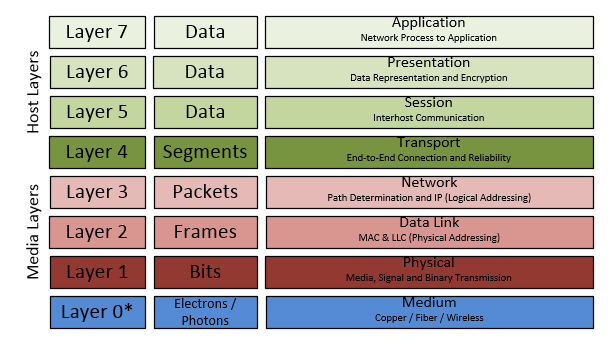OSI Seven-Layer Model: Where Does Layer 0 Fit In?
The OSI seven-layer model looks like this:

But one important component is missing from the OSI seven-layer model: the cabling infrastructure. There has been an ongoing industry debate about whether layer 1 is the same as what has been dubbed “layer 0” to represent cabling infrastructure. We think the answer to that question is “no” – and here’s why.
As the OSI seven-layer model describes, layer 1 is known as the “physical layer.” It’s the first and lowest layer in the model, and is where defined electronic signals are transmitted and received. It involves the transmission of raw bits – not logical data packets – and serves as an interface with the data link layer. Here is where you’ll likely find the bit stream grouped into symbols that is converted to a physical signal. Layer 1 doesn’t define things like cabling infrastructure pathways, racks, cabinets or cable management.
As some in our industry have explained, layer 1 “plays” with physical connections, such as cabling, connectors and network interface cards. But this layer does not deal directly with the physical medium: the copper or fiber cabling, for example.
Because cabling doesn’t “fit” into layer 1 of the OSI seven-layer model – and also doesn’t fit into any other layer – we like to refer to cabling infrastructure as layer 0. It’s the most important layer in your network infrastructure, and the key to ensuring consistent, reliable, fast communication among network devices (connected wirelessly or not).
Layer 1 is definitely important in ensuring reliable signal transmission. But layer 0 offers an opportunity to create a foundation that can adequately support the layers identified in the OSI seven-layer model.
Another key difference between layer 1 and layer 0 is the frequency of replacement or upgrades. The components in the physical layer as defined by the OSI seven-layer model are often replaced three to five years as technology changes. Layer 0, however, is often in place for 15 or 20 years – or longer. This means that it must be designed to last – and support whatever changes take place in that time.
A well-designed, properly installed layer 0 following TIA standards and guidelines offers many benefits:
- Reduced signal loss, thanks to proper cables, support and routing – which ultimately optimizes network performance
- Simplified network maintenance and faster, easier moves, adds and changes that can be completed without a lot of network downtime
- Support for increasing technology and bandwidth demands
On the other hand, a layer 0 that isn’t well designed or properly installed can cause:
- Inhibited signal transmission
- Lack of flexibility or scalability over time
- Difficult, time-consuming moves, adds and changes
- Complicated maintenance requirements
For example: As our workplaces move toward a digital-building model, more devices will connect to networks. This will require more wireless access points to allow IP devices to connect to a wired network, as well as a cabling infrastructure that can support this influx of devices.
A digital building can’t function as intended, and provide all of the benefits promised, if its cabling system – layer 0 – isn’t designed to support it. There will be a limit to the number of devices that connect, whether or not they can communicate, how fast data transmission can occur and whether bottlenecks and slowdowns transpire during periods of heavy use.
Belden specializes in layer 0, helping enterprises select and deploy cabling infrastructure to support the people, devices and applications connecting to your network. Each layer 0 should be designed differently, based on the needs of the enterprise. We take time to truly understand what you need – and what you don’t – to address the most critical areas of your network.
